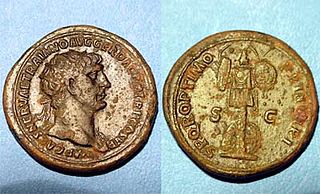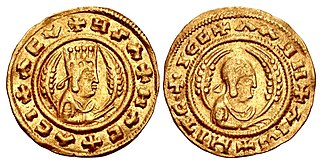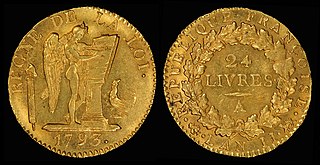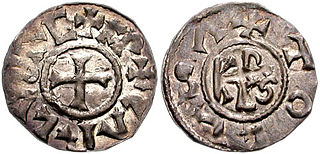![A denarius minted c. 18 BC during the reign of Augustus; Obverse: CAESAR AVGVSTVS; reverse: comet of eight rays with tail upward; DIVVS IVLIV[S] (DIVINE JULIUS). S0484.4.jpg](http://upload.wikimedia.org/wikipedia/commons/thumb/1/1e/S0484.4.jpg/220px-S0484.4.jpg)
The coinage reform of Augustus refers to the reform of Roman currency undertaken by Augustus in 23 BC.
![A denarius minted c. 18 BC during the reign of Augustus; Obverse: CAESAR AVGVSTVS; reverse: comet of eight rays with tail upward; DIVVS IVLIV[S] (DIVINE JULIUS). S0484.4.jpg](http://upload.wikimedia.org/wikipedia/commons/thumb/1/1e/S0484.4.jpg/220px-S0484.4.jpg)
The coinage reform of Augustus refers to the reform of Roman currency undertaken by Augustus in 23 BC.
Augustus brought the minting of gold and silver coins, the aureus and denarius, under his personal control while it is thought he left the minting of bronze coinage under senatorial control. [1] Throughout these reforms, Augustus did not alter the coins' weight or fineness. The gold aureus, weighing about one-quarter ounce, was worth twenty-five silver denarii, weighing about one-eighth of a troy ounce. [2]
Augustus more comprehensively reformed denominations below the denarius. New ratios were fixed among the currencies: the sestertius was now minted from about an ounce of orichalcum, an alloy of copper and zinc, rather than silver, and fixed at a quarter of a denarius. The dupondius, formerly a two-pound bronze coin, was now orichalcum, valued at half a sestertius and weighing half as much. The half-ounce as , worth half a dupondius, the semis, worth half an as, and the quadrans, worth half a semis, were the first pure copper coins minted in Rome since 84 BC. [3]

A coin is a small object, usually round and flat, used primarily as a medium of exchange or legal tender. They are standardized in weight, and produced in large quantities at a mint in order to facilitate trade. They are most often issued by a government. Coins often have images, numerals, or text on them. The faces of coins or medals are sometimes called the obverse and the reverse, referring to the front and back sides, respectively. The obverse of a coin is commonly called heads, because it often depicts the head of a prominent person, and the reverse is known as tails.

The denarius was the standard Roman silver coin from its introduction in the Second Punic War c. 211 BC to the reign of Gordian III, when it was gradually replaced by the antoninianus. It continued to be minted in very small quantities, likely for ceremonial purposes, until and through the Tetrarchy (293–313).

Electrum is a naturally occurring alloy of gold and silver, with trace amounts of copper and other metals. Its color ranges from pale to bright yellow, depending on the proportions of gold and silver. It has been produced artificially and is also known as "green gold".

The as, occasionally assarius, was a bronze, and later copper, coin used during the Roman Republic and Roman Empire.

The sestertius or sesterce was an ancient Roman coin. During the Roman Republic it was a small, silver coin issued only on rare occasions. During the Roman Empire it was a large brass coin.

The dupondius was a brass coin used during the Roman Republic and Roman Empire valued at 2 asses.

Roman currency for most of Roman history consisted of gold, silver, bronze, orichalcum and copper coinage. From its introduction during the Republic, in the third century BC, through Imperial times, Roman currency saw many changes in form, denomination, and composition. A feature was the inflationary debasement and replacement of coins over the centuries. Notable examples of this followed the reforms of Diocletian. This trend continued with Byzantine currency.

Orichalcum or aurichalcum is a metal mentioned in several ancient writings, including the story of Atlantis in the Critias of Plato. Within the dialogue, Critias says that orichalcum had been considered second only to gold in value and had been found and mined in many parts of Atlantis in ancient times, but that by Critias's own time, orichalcum was known only by name.

The franc, also commonly distinguished as the French franc (FF), was a currency of France. Between 1360 and 1641, it was the name of coins worth 1 livre tournois and it remained in common parlance as a term for this amount of money. It was reintroduced in 1795. After two centuries of inflation, it was redenominated in 1960, with each new franc (NF) being worth 100 old francs. The NF designation was continued for a few years before the currency returned to being simply the franc. Many French residents, though, continued to quote prices of especially expensive items in terms of the old franc, up to and even after the introduction of the euro in 2002. The French franc was a commonly held international reserve currency of reference in the 19th and 20th centuries. Between 1998 and 2002, the conversion of francs to euros was carried out at a rate of 6.55957 francs to 1 euro.

The aureus was a gold coin of ancient Rome originally valued at 25 pure silver denarii. The aureus was regularly issued from the 1st century BC to the beginning of the 4th century AD, when it was replaced by the solidus. The aureus was about the same size as the denarius, but heavier.

The semis was a small Roman bronze coin that was valued at half an as. During the Roman Republic, the semis was distinguished by an 'S' or 6 dots. Some of the coins featured a bust of Saturn on the obverse, and the prow of a ship on the reverse.
The pfennig ; symbol pf or ₰) or penny is a former German coin or note, which was the official currency from the 9th century until the introduction of the euro in 2002. While a valuable coin during the Middle Ages, it lost its value through the years and was the minor coin of the Mark currencies in the German Reich, West Germany and East Germany, and the reunified Germany until the introduction of the euro. Pfennig was also the name of the subunit of the Danzig mark (1922–1923) and the Danzig gulden (1923–1939) in the Free City of Danzig.
Roman Republican currency is the coinage struck by the various magistrates of the Roman Republic, to be used as legal tender. In modern times, the abbreviation RRC, "Roman Republican Coinage" originally the name of a reference work on the topic by Michael H. Crawford, has come to be used as an identifying tag for coins assigned a number in that work, such as RRC 367.

Aksumite currency was coinage produced and used within the Kingdom of Aksum centered in present-day Eritrea and Ethiopia. Its mintages were issued and circulated from the reign of King Endubis around AD 270 until it began its decline in the first half of the 7th century where they started using Dinar along with most parts of the Middle East. During the succeeding medieval period, Mogadishu currency, minted by the Sultanate of Mogadishu, was the most widely circulated currency in the eastern and southern parts of the Horn of Africa from the start of the 12th century.

Silver coins are one of the oldest mass-produced form of coinage. Silver has been used as a coinage metal since the times of the Greeks; their silver drachmas were popular trade coins. The ancient Persians used silver coins between 612–330 BC. Before 1797, British pennies were made of silver.

The livre was the currency of Kingdom of France and its predecessor states of Francia and West Francia from 781 to 1794. Several different livres existed, some concurrently. The livre was the name of coins and of units of account.

Like the Egyptians, Phoenicians and Carthaginians, the Etruscans were rather slow to adopt the invention of coinage. The brief period of Etruscan coinage, with the predominance of marks of value, seems to be an amalgam that reconciles two very different monetary systems: the 'primitive' bronze-weighing and aes grave economy of central Italy with that of struck silver and gold issues of southern Italian Greek type not familiar in Etruria.

Italy has a long history of different coinage types, which spans thousands of years. Italy has been influential at a coinage point of view: the medieval Florentine florin, one of the most used coinage types in European history and one of the most important coins in Western history, was struck in Florence in the 13th century, while the Venetian sequin, minted from 1284 to 1797, was the most prestigious gold coin in circulation in the commercial centers of the Mediterranean Sea.

The Carolingian monetary system, also called the Carolingian coinage system or just the Carolingian system, was a currency structure introduced by Charlemagne in the late 8th century as part of a major reform, the effects of which subsequently dominated much of Europe, including Britain, for centuries. It is characterised by having three denominations with values in the ratio 1:20:240, the units of which went under different names in the different languages, but which corresponded to the Latin terms libra (pound), solidus (shilling) and denarius (penny), respectively.